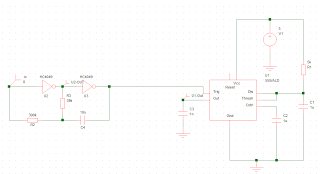Sunday, July 18, 2010
Pulse Oximeter project continued
You can follow the progress of that project at:
http://pulseoxwireless.blogspot.com/
Tuesday, June 8, 2010
Heart Beat and SpO2 detection
Friday, June 4, 2010
Clock Timing nightmare
Sunday, May 23, 2010
Non overlapping Clock generator
Saturday, May 15, 2010
TIA status and Software Update
PGA Simulation LabVIEW
A simulation was run to mimic the future role of our software. Having implemented DC detection we can now determine the DC bias from the ADC. In the future this software must be able to detect the DC bias and attempt to remove it by writing dynamic software to control the DACs. In addition the software must be able to detect the peak-to-peak signal amplitude and reason how to provide gain. Gain is provided by using a Programmable Gain Amplifier (PGA) to provide gain in steps.
The first simulation ran demonstrated what the PGA will do. A sine function with a random AC amplitude (0 to 100mV) was generated. I then built a stage capable of detecting the peak-to-peak AC amplitude. I then used a for loop to run through each PGA options (1, 2, 5, 10, 20, etc.) to check if the signal was above 5 volt. If the signal was less than 5 volt then it is selected as the true PGA. In the figure below you will see operation of several different simulations. As you can see, with different random AC amplitude the gain is dynamically modified.maximum dynamic range of the signal would be 5 v.
The simulation below show the response of the simulation to different initial signal AC amplitudes. As can be seen, a smaller AC amplitude will allow a higher gain value.
Sunday, May 2, 2010
PGA Simulation Sunday Update
1) As for the randomness of the amplitude of the signal, I have a bit of code in there that provides randomness, although is not hooked up to the sine wave just yet.
a) My first question about it, is that it is giving me integers, and I am not all that great with the types, so I am wondering if there is a way to make it do decimal values rather than U32 values.
b)My second question is that when I attach it to the amplitude, I need a way to have it pick a random number only once rather than constantly changing the amplitude. I am not sure how to do this. I am thinking of using a loop to only make it grab one of the random values, but still am uncertain of how.
2) The sine wave seems to be a nice wave right now. It was a bit tricky for me to get the max and min working, although, it does give me max and min values of y and x separately, which is neat, (i.e. ymin and ymax and xmin and xmax). This is really useful.
a) I have used this to my advantage of taking the ymax and using logic to see if it falls within a range of values (right now I have it set in a range of 4.75 to 5 V, which will likely need to be changed later so there is less error.) With this being said, when it is true, it goes to a true/false case where true does nothing and false has logic further asking if the value was less than 4.75 V, and I would like this to multiply by a particular number to act as the PGA does, so in the first case, multiply by 2. I have the ymax go into this case, but I don't know quite how implement this with having an array of values coming in.
b) The array of values need to be paired back up with the time values. Not certain of how to do this.
c) Of course, with each trial check through the PGA, the gain (or number multiplied by will need to change). Again, I think that this is some sort of loop where i increments (maybe for loop), but I need help on figuring the increment portion.
3) I have not looked at the implementation of adding a DC value for smaller adjustments just yet. Also, it can be noted that for now, the signal is starting out at 2.5 V as it would be assuming that the DC finder was working at this stage.
During lab, I will meet with my team and see what advice they have. Hopefully by the end of lab, there will be a running PGA simulation that fully works.









